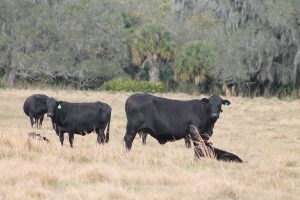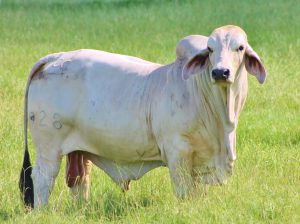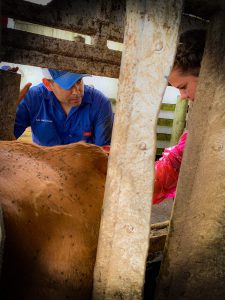Did you know that Florida ranks 9th in the nation when it comes to cow-calf numbers? Beef cattle production was instrumental in building Florida’s economy. Our state was the first to have a beef industry, and today, more than 500 years after the first Spanish cow set hoof on our soil, local economies are still benefiting from the ability to convert grass into pounds of meat.

It is estimated that the Sunshine State is home to 888,000 beef cows that produce top quality steers and heifers that contribute to the abundant supply of red meat in our grocery stores nationwide. And today’s industry, as well as the pressures and decisions made by the contemporary cattleman are very different than the reality that our counterparts 50 years ago had to experience.
It’s all about economics
Due to external factors such as production costs, land prices, and the onset of cost-effective technologies, today’s cattle producer needs to invest their efforts into learning and managing their resources differently. Expensive inputs such as fuel and fertilizer can break an operation if production goals are not met. So, this article will focus on ensuring that we talk about an area where small decisions can produce big changes in the efficiency of your cattle enterprise. This is the foundation for solid production: reproductive efficiency.
Beef cattle producers need to have sound reproductive management to ensure the success and profitability of their operations. Reproductive management is defined as: the framework that ensures that cattle fertility, followed by adequate immunological and environmental conditions leads to calving healthy animals (my definition).
Reproduction is a crucial aspect of beef cattle production as it directly influences the number of calves produced each year, the genetic improvement of the herd, and the overall productivity of the operation. Therefore, implementing effective reproductive management practices is essential for maximizing the reproductive performance of the herd.
Focus on nutrition
One of the key practices that beef cattle producers should incorporate to improve reproductive performance is ensuring optimal nutrition for their cattle. Proper nutrition plays a vital role in the

overall health and reproductive capacity of the animals. Adequate nutrition helps to maintain a healthy body condition score, which is important for the initiation and maintenance of pregnancy in beef cows. A body condition score of around 5 to 6 on a scale of 1 to 9 is considered ideal for reproductive success. Cattle with a lower body condition score may experience delayed or failed conception, while those with a higher body condition score may exhibit reduced fertility and calving difficulties. Therefore, providing a balanced diet that meets the nutritional requirements of the animals, especially during critical periods such as breeding and early gestation, is crucial for optimizing reproductive performance.
Proactive disease prevention is key
Sexually transmitted diseases can spread across the herd without us even noticing. This is why it is recommended to test bulls for diseases such as Trichomoniasis. The microorganism that carries this disease lives in the bull’s reproductive organs and can be disseminated throughout the herd as cows come in heat and get bred by your sires. It is recommended that you test your bulls at least 60 days before your breeding season looking at multiple factors that influence their ability to perform. Ask your veterinarian for information on Breeding Soundness Exam, where they look at the exterior and interior organs, measure volume and shape of bull’s sperm, as well as help detect underlying problems well in advance of the critical time for your males to perform.

Prevent diseases through immunization
There are many diseases that can affect the reproductive ability of your cows. Some of these can cause early or late term abortions, uterine infection, and even affect the health of the unborn calf, making it a carrier for life, thus a liability. Vaccination protocols for your area are designed by your local veterinarian to protect your herd from preventable diseases that are common in your area. This is why we continue to encourage the use of their expertise on this matter.
Manage when cows conceive by establishing a breeding season
All managed cattle should have a set breeding season. A breeding season is defined as a period of time when cows are expected to come in heat and breed. Ideal or suggested breeding seasons of 60 – 90 days are commonly suggested (cows estrus cycle is on average 21 days long). During this time cows are exposed to a herd bull (typically 25 females for every sire). The cows that don’t get pregnant during this time can be moved back to a 2nd breeding season or gradually replaced by more fertile animals. The end result should be that all cows in the herd calve at the same time, so cattlemen can manage and market their calf crop more efficiently.
Consider pregnancy diagnostics
There are several ways to determine if your animals are pregnant or not. Some of these techniques are rectal palpation, ultrasound scanning, and blood testing. All of these are better options than waiting nine months for a calf to drop. The advantages of establishing who is carrying a baby in her belly are many, such as deciding is a cow is culled from the herd or retained. Open cattle can be re-exposed to a bull on a second breeding season. You can also market a pregnant cow if you know that she is expecting, and you need to sell her. It is worth noting that with ultrasound scanning at the correct time (60 to 80 days after conception) you can even determine the sex of a fetus.

Other alternative management strategies
- Selecting for good reproductive traits – When selecting bulls and replacement heifers, beef cattle producers should choose animals that have a history of good reproductive performance. This includes animals that have a high conception rate, a short calving interval, and healthy calves.
- Using artificial insemination – This technique can be a valuable tool for improving the reproductive performance of beef cattle herds, as well as introducing superior genetics. Artificial insemination allows producers to use semen from tested bulls with superior genetics, even if those bulls are not located near the herd. It also eliminates the risk of sexually transmitted diseases.
- Minimizing environmental stress – Heat stress can also affect the reproductive performance of beef cattle. Producers should try to minimize stress in their herds by providing adequate space, good ventilation, and clean water.
Gradual changes to the way we manage our cow-calf operation can have big impacts. Conception rates need to be measured, and one extra calf or two can often pay for the corrective actions we establish. Remember: There is no production without reproduction.
If you need further information on this topic, please contact Jonael Bosques, UF/IFAS Extension Hardee County Agriculture agent at 863-773-2164, or come by our office located at 507 Civic Center Dr, Wauchula FL 33873.
Keep learning!
- Ranking Of States With The Most Beef Cows – Beef2Live | Eat Beef * Live Better
- Body Condition Scoring of Beef Cattle, G2230 | MU Extension (missouri.edu)
- AN365/AN365: Calculating Reproductive Performance in Beef Operations: The University of Florida Beef Herds’ 2019 Breeding Season (ufl.edu)
- AN208/AN208: What Is the Economic Impact of Infertility in Beef Cattle? (ufl.edu)
- AN267/AN267: Converting the Beef Cow Herd to a Controlled Breeding Season (ufl.edu)
- AN379/AN379: Analysis of the USDA’s 2017 Cow-Calf Management Practices Results: Part 2—Breeding Practices/Reproductive Technologies (ufl.edu)
- AN218/AN218: Considerations for Selecting a Bull (ufl.edu)
- Herd Health Programs and Reproductive Efficiency of Beef Cattle (missouri.edu)
- Determination of Pregnancy Status in Beef Herds (missouri.edu)
- Reproductive Management of Commercial Beef Cows | UGA Cooperative Extension
- Heat Stress and Reproduction in Beef Cattle | USU
 1
1
